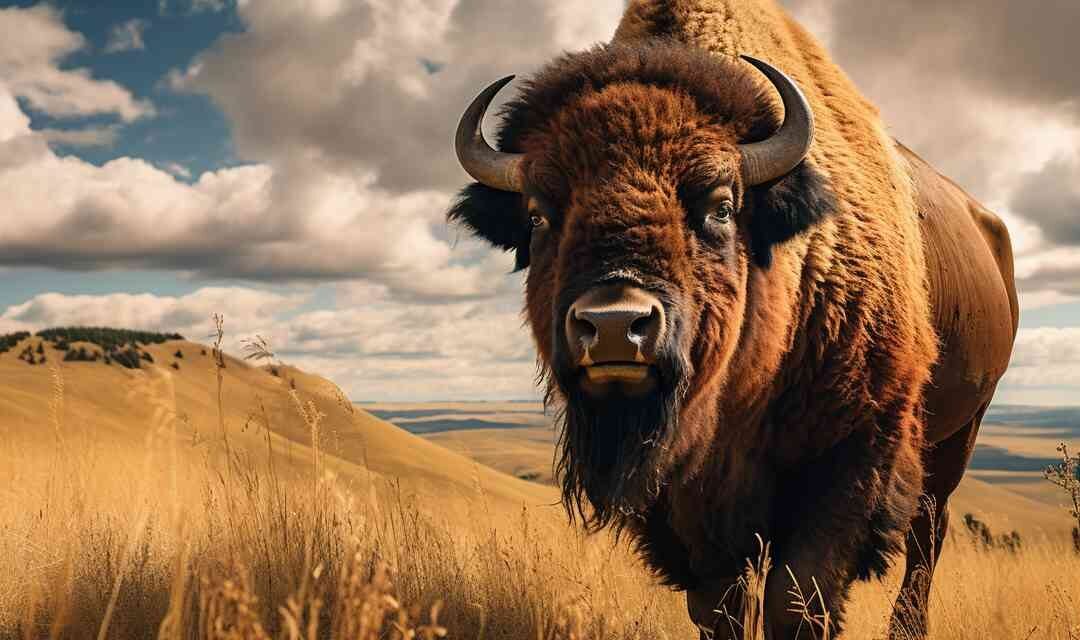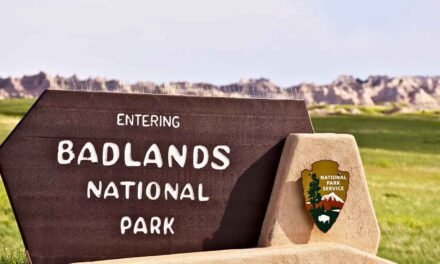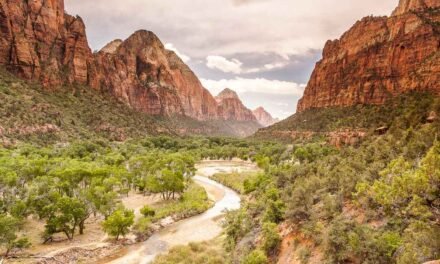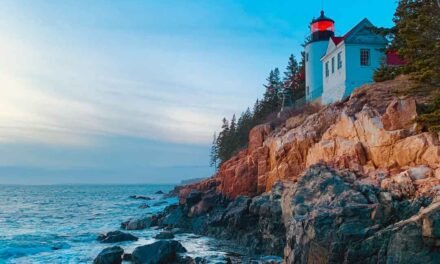Badlands National Park is a geological wonder located in South Dakota, USA. The park boasts of stunning landscapes, unique rock formations, and diverse wildlife. However, behind the beauty of the park lies a complex and often tragic history, including the displacement of Native American tribes from their ancestral lands.
In this article, we will explore the history of Badlands National Park, from its formation millions of years ago to the establishment of the park and its conservation efforts. We will also delve into the experiences of the Native American tribes who called the Badlands their home and the impact of early explorers and settlers on the region.
Additionally, we will discuss the current state of the park and its future prospects. Through this journey, we hope to provide an in-depth and comprehensive understanding of the Badlands and its place in American history and culture.
Formation of the Badlands
The unique geological formations that make up the current landscape of Badlands National Park were formed through a complex process of erosion and deposition over millions of years. Erosion patterns caused by wind and water played a significant role in shaping the Badlands landscape.
The park’s geological formations consist of various sedimentary layers that were gradually deposited over time. These layers were then subjected to a series of erosive forces that shaped the current terrain.
Fossil records and paleoclimate data have helped scientists reconstruct the environmental conditions that existed during the formation of Badlands National Park. The park’s sedimentary layers contain a rich record of the region’s past, with fossils of ancient mammals such as rhinoceroses, horses, and camels.
The park’s paleoclimate data suggests that the region was once much wetter and supported a diverse array of plant and animal life. The erosion patterns and sedimentary layers that make up the Badlands landscape serve as a fascinating example of the geological forces that shape our planet.
Early Geology of the Region
The region was once filled with vast inland seas and dense swamps that slowly eroded over millions of years, leaving behind intricate layers of sedimentary rock formations.
The geological timeline of Badlands National Park dates back to the Late Cretaceous period, approximately 75 million years ago.
The sediment deposits in the region consist of sandstone, mudstone, and shale.
The erosion patterns caused by wind and water over time have carved out the unique rock formations that we see today, including pinnacles, spires, and canyons.
Fossil evidence found in the Badlands reveals that the region was once home to a diverse range of prehistoric creatures such as dinosaurs, mammals, and reptiles.
The fossils provide a glimpse into the ecosystem that existed millions of years ago and help scientists understand the evolution of life on earth.
The Badlands’ early geology provides an exciting look into the past and a unique opportunity to study the formation of sedimentary rock formations and the forces of erosion that shaped them.
Native American Tribes and the Badlands
Indigenous communities, including the Oglala Lakota and Cheyenne, have lived in the region that is now Badlands National Park for thousands of years. These tribes have deep cultural ties to the land, with traditional practices and values that have been passed down through generations.
Native American relations with the United States government, however, have been complicated and often painful. The forced removal of tribes from their ancestral lands, including those in the Badlands region, has had lasting effects on these communities.
Despite this, efforts to preserve Native American culture and history in the park continue to this day. Visitors can learn about the traditional practices of the Lakota and Cheyenne through interpretive programs and exhibits.
The impact of modern society on Native American communities cannot be ignored. The construction of highways and other infrastructure has disrupted traditional ways of life and altered the landscape. Additionally, climate change has had a significant impact on the region, with rising temperatures and droughts affecting wildlife and vegetation.
In recent years, the National Park Service has worked with Native American tribes to address these challenges and promote cultural preservation. For example, the park has partnered with the Oglala Sioux Tribe to reintroduce bison to the region, a species that holds cultural significance for the Lakota people. These efforts demonstrate a commitment to recognizing and honoring the important role that Native American communities continue to play in the history and culture of Badlands National Park.
Early Explorers and Settlers
Explorers and settlers arrived in the region that is now known as Badlands, leading to significant changes in the landscape and traditional ways of life for the Native American tribes that had lived there for thousands of years.
Some of the exploration challenges that early explorers faced were the harsh terrain and unpredictable weather conditions. Despite these challenges, expeditions such as the 1823-1824 Missouri River Expedition led by Stephen Long and the 1853-1854 Pacific Railroad Survey led by Isaac Stevens, helped to map and document the region.
These expeditions also brought attention to the area, which eventually led to pioneer settlement in the late 1800s.
Pioneer settlement brought frontier life to the Badlands, as homesteaders struggled to make a living in the harsh prairie environment. Prairie agriculture was difficult due to the lack of water, unpredictable weather, and the rugged terrain.
Homesteaders had to learn how to adapt to these conditions and find ways to survive. Despite the challenges, settlers established towns and communities, and some even became successful ranchers.
The arrival of settlers forever changed the Badlands, as they brought with them a new way of life and culture.
Establishing Badlands National Park
The process of establishing Badlands National Park involved complex negotiations between various stakeholders, including political tensions among local and national government agencies, Native American tribes, and conservation groups.
In 1939, the National Park Service conducted surveys of the region to assess its potential as a protected area. However, the process was delayed due to World War II and political debates between pro-conservation and pro-development groups.
It was not until 1962 that President John F. Kennedy signed the Badlands National Park bill into law, which established the park’s boundaries and protected the unique geological formations and wildlife in the region.
The establishment of Badlands National Park had significant environmental impacts, including the protection of rare species such as the black-footed ferret, bison, and pronghorn antelope. The park’s unique landscape attracts millions of visitors each year, providing economic benefits to local communities through tourism-related businesses.
However, the establishment of the park also had cultural significance for the Lakota Sioux, who were forcibly removed from the region in the late 19th century. Today, the park works with the Lakota Sioux to preserve their cultural heritage and promote educational programs about their history in the region.
The establishment of Badlands National Park demonstrates the importance of community involvement and collaboration among stakeholders to protect and preserve natural and cultural resources for future generations.
Recreational Opportunities
Visitors to Badlands National Park have a wide range of recreational opportunities to choose from.
Hiking trails are available for all levels of experience, ranging from easy walks to more challenging hikes. The park offers over 100 miles of trails, with options for guided hikes and interpretive walks.
Camping sites are also available for visitors who wish to stay overnight, with two campgrounds offering a total of 100 sites.
In addition, there are several picnic areas located throughout the park, providing a perfect spot for a meal or snack.
Wildlife watching is another popular activity in Badlands National Park.
Visitors can observe various species of animals, including bison, bighorn sheep, pronghorns, coyotes, and prairie dogs, among others.
The park also offers several photography spots, perfect for capturing stunning views of the colorful rock formations and the expansive landscapes.
Whether visitors prefer to hike, camp, watch wildlife, or take photographs, Badlands National Park has something for everyone to enjoy.
Geology and Ecosystems of the Park
The unique geological formations and diverse ecosystems of Badlands National Park offer a rich opportunity for scientific study and exploration.
The park is home to a range of unique rock formations, including layered sedimentary rocks, spires, and pinnacles. These formations have been shaped by millions of years of erosion, and have also yielded important fossil discoveries.
Paleontologists have uncovered a range of fossils in the park, including the remains of ancient camels, horses, and rhinoceroses. These fossils offer important insights into the evolution of the North American continent.
In addition to its geological formations, Badlands National Park is home to a range of ecosystems, including prairie grasslands and mixed-grass prairies. The park is also home to a bison herd, which is one of the largest and most genetically pure herds in the United States.
The park’s unique ecosystems provide important habitat for a range of endangered species, including the black-footed ferret, swift fox, and prairie dog. The park’s commitment to endangered species conservation has helped to ensure the continued survival of these important species, and underscores the importance of protecting our nation’s natural heritage.
Wildlife of the Badlands
The diverse range of wildlife in Badlands National Park is one of the main attractions for visitors.
The park is home to a variety of animals, including bison, prairie dogs, bighorn sheep, and a range of reptile species.
The park also offers opportunities for birdwatching, with over 200 species of birds recorded in the area.
The park’s bison population is particularly noteworthy, with a seasonal migration that takes them across the park’s grasslands.
Visitors can observe these massive animals as they move across the plains in search of food and water.
Prairie dogs are another common sight in the park, with their distinctive barks echoing across the landscape.
Bighorn sheep can also be spotted in the park’s rocky terrain, while reptile enthusiasts can observe a variety of species, including rattlesnakes, garter snakes, and prairie lizards.
Historic Events and Landmarks
The rugged terrain of Badlands National Park bears the stories of those who once called this land their home, including Native American communities whose cultural heritage and spiritual beliefs are deeply intertwined with the natural world.
The park also has a rich history of significant events and landmarks that have shaped the landscape over time. Here are four examples of these historic events and landmarks:
- Fossil discoveries: Badlands National Park is home to one of the world’s richest fossil beds, with evidence of prehistoric animals dating back to the Oligocene epoch. The park’s paleontological resources are protected and studied by scientists who continue to uncover new discoveries that shed light on the history of life on Earth.
- Military presence: During the late 1800s, the U.S. Army established several posts in the Badlands region to protect settlers and travelers along the frontier. Some of the most notable military landmarks in the park include the Stable and Barracks at Fort Hays, which served as a logistical base for troops during the Indian Wars.
- Impact of weather: The Badlands region is known for its extreme weather conditions, including heavy rainfall, lightning strikes, and tornadoes. These weather patterns have shaped the landscape over time, with erosion and sedimentation creating the unique rock formations and colorful layers that make up the park’s iconic Badlands Wall.
- Cultural significance: The Badlands region has been a sacred site for Native American tribes for thousands of years, with spiritual and cultural traditions deeply rooted in the land. Visitors can learn about these traditions by exploring the park’s exhibits and attending cultural programs and events.
- Tourist attractions: The park is a popular tourist destination, with a variety of attractions to explore, including hiking trails, scenic drives, and wildlife viewing opportunities. Visitors can also participate in ranger-led tours and activities that provide a deeper appreciation for the park’s rich history and natural wonders.
Conservation of the Badlands
Preserving the unique natural features of Badlands National Park is a top priority for land management efforts. The park’s diverse ecosystem is home to a range of flora and fauna, including bison, bighorn sheep, and pronghorn antelope.
Conservation efforts at the park include ongoing research and management strategies aimed at protecting these species and their habitat. One such strategy is the establishment of wildlife corridors, which allow animals to safely move between different parts of the park. Park rangers also work to minimize the environmental impact of human activities, such as by implementing sustainable waste management practices and promoting responsible hiking and camping behaviors.
In addition to conservation efforts, the park also prioritizes public education and park infrastructure as a means of promoting sustainability. Visitors to Badlands National Park can participate in educational programs and guided tours to learn more about the park’s history and ecology. The park also features a number of sustainable infrastructure projects, such as solar panels and energy-efficient buildings, which help to reduce the park’s carbon footprint.
These efforts contribute to a more sustainable future for the park and its surrounding ecosystem, while also providing visitors with a unique and memorable experience.
Badlands National Park Today
Efforts to maintain the natural diversity and ecological balance of Badlands National Park are ongoing and involve a range of activities.
Ecotourism activities are an important part of the park’s conservation strategy, as they allow visitors to enjoy the natural beauty of the area while minimizing their impact on the environment.
The park features scenic trails that wind through stunning rock formations and offer a glimpse into the area’s unique geological history.
Visitors can also participate in educational programs that focus on the importance of wildlife preservation and the role that the park plays in protecting endangered species.
The park’s visitor center is another important component of its conservation efforts. Here, visitors can learn about the park’s history and ecology, as well as participate in programs that promote sustainable conservation practices.
The center also offers information about the park’s camping facilities, which are designed to minimize their impact on the environment while providing visitors with a comfortable and enjoyable camping experience.
Overall, the park’s efforts to balance conservation with public use are an ongoing priority that ensures that Badlands National Park will continue to be a source of inspiration and wonder for generations to come.
Future of Badlands National Park
Strategies to maintain ecological balance and preserve natural diversity in Badlands National Park continue to be a top priority in ensuring the park’s sustainability for future generations.
Visitors impact management plans are in place to minimize the impact of the increasing number of tourists on the park’s fragile ecosystem.
The park has also adopted measures to address the impact of climate change, such as reducing carbon emissions and promoting sustainable practices.
Improving park infrastructure is another key element in ensuring the park’s sustainability.
The park has implemented measures to improve visitor facilities, including upgrading trails, campgrounds, and visitor centers.
Wildlife management practices are also being implemented to protect native species and prevent the spread of invasive species.
Cultural preservation is another important aspect of the park’s sustainability efforts, with initiatives to protect and preserve the cultural heritage of the Lakota and other indigenous people who have called the area home for centuries.
Through these efforts, the park is poised to continue to provide visitors with an unforgettable experience while preserving the natural and cultural resources for future generations to enjoy.
Frequently Asked Questions
What impact did the construction of the railroads have on the Badlands region and its Native American inhabitants?
The construction of railroads in the Badlands region had a significant impact on the native American inhabitants.
The railroads brought economic development to the region, but at a high cost to the indigenous people.
The railroads displaced the native populations from their ancestral lands, leading to the loss of their cultural heritage.
Despite facing forced removal, the indigenous people continued to resist the efforts of the government and the railroad companies.
They fought to preserve their cultural practices and traditions amidst the rapid changes brought by the railroads.
The impact of the railroads on the Badlands region is a complex history that highlights the ongoing struggles of the indigenous populations in preserving their cultural heritage.
How has the management and conservation of the Badlands changed over time?
Preservation techniques, environmental initiatives, community involvement, government policies, and local advocacy have all played significant roles in the management and conservation of Badlands National Park over time.
The park has implemented various preservation techniques such as controlled burns and wildlife management to maintain the natural balance of the ecosystem.
Environmental initiatives have been established to minimize the park’s carbon footprint, including the use of renewable energy sources.
Community involvement has also been key in the park’s management, with local volunteers contributing to conservation efforts and educating visitors on sustainable practices.
Government policies have been put in place to regulate activities within the park and protect its natural resources.
Local advocacy groups have also played a vital role in advocating for the park’s preservation, including fighting against proposals to drill for oil within its boundaries.
Over time, the management and conservation of Badlands National Park has evolved to prioritize sustainable practices and the protection of its unique natural resources.
Are there any endangered species that call the Badlands home?
Endangered species in Badlands National Park include the swift fox, black-footed ferret, and the northern long-eared bat.
Conservation efforts have been implemented to protect the habitats of these species and prevent further population decline.
Habitat protection and ecosystem restoration projects have been completed to support the needs of these endangered species.
Wildlife management practices have also been implemented to reduce threats such as poaching and habitat fragmentation.
Ongoing research and monitoring efforts are conducted to ensure the effectiveness of these conservation measures.
With a continued focus on conservation, these endangered species can thrive and contribute to the biodiversity of Badlands National Park.
What is the significance of the unique rock formations found in the Badlands?
Geological formations in Badlands National Park are a result of intricate erosion processes that have occurred over millions of years. The unique rock formations are composed of layered rock formations that have been exposed through the forces of erosion.
The fossil deposits found in the park are a testament to the paleontological discoveries that have been made in the area. These fossil deposits provide insight into the ancient history of the region and the creatures that once called it home.
The cultural significance of the park is also noteworthy, as it has been a sacred site for Native American tribes for centuries.
The park’s geological formations and paleontological discoveries have been instrumental in shaping our understanding of the earth’s history, and continue to provide a valuable resource for scientific research.
How has the tourism industry affected the Badlands and its surrounding communities?
Tourism has brought significant economic benefits to the Badlands National Park and its surrounding communities. The park attracts millions of visitors, generating revenue from entrance fees, lodging, and other recreational activities.
However, this influx of tourists has also had environmental impacts, such as increased traffic, pollution, and degradation of natural resources. To mitigate these effects, the park has implemented sustainable practices and educational programs to promote conservation and preservation efforts. Infrastructure development, such as the construction of hiking trails and visitor centers, has also improved the overall visitor experience.
Additionally, the park has engaged with local communities to promote cultural preservation and foster community engagement. Despite challenges, the tourism industry in the Badlands has created opportunities for economic growth and cultural exchange while striving to maintain the park’s natural beauty and ecological balance.
Conclusion
The history of Badlands National Park is a complex and multifaceted story that spans millions of years.
From the formation of the unique rock formations to the forced removal of Native American tribes, the park’s history is filled with triumphs and tragedies.
Despite the challenges faced by the park’s inhabitants over the years, its conservation efforts have ensured that future generations can continue to appreciate its natural beauty and significance.
Today, Badlands National Park remains a popular destination for tourists and nature enthusiasts alike.
Its stunning vistas and unique geological features continue to inspire awe and wonder in visitors from all over the world.
As the park looks to the future, it is important to continue prioritizing conservation efforts and honoring the complex and often painful history of the lands on which it sits.
By doing so, we can ensure that Badlands National Park remains a cherished national treasure for generations to come.





